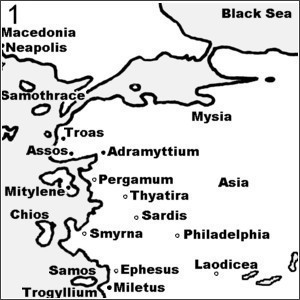
By Command of Christ
—Some notes on Revelation 1:9-11
The Revelation of Christ (Revelation 1-5) >The Prologue >The Introduction >Resource: supplementary study notes
This page looks at the portion of John’s prologue to Revelation where he informs us of the circumstances that caused him to write the book. The book was written because Jesus commanded it to be written. This command came immediately before the visions were seen by John.
1 The Seer
John The "John" who introduces himself here (Revelation 1:4), is most likely John the apostle who wrote the gospel and the three epistles that also bear his name. Some insist that it is a different John, because the language style differs from the other books.
However that is explained in that John is writing a different manner of book, and doing so under the thrall of the visions being shown to him (note Revelation 10:4).
2 The Places
Asia The "Asia" here (Revelation 1:4), is not what we call Asia today, but rather Asia Minor, the area of which Ephesus is the major city.
Patmos John was on a small island off the coast south of Ephesus and below Samos. There he would be able, undisturbed, to receive "the word of God and the testimony of Jesus" . It is necessary, sometimes, to go away to a lonely place in order to be "in spirit".
Seven churches The seven churches to whom the letter was originally circulated were in Ephesus, Smyrna, Pergamum, Thyatira, Sardis, Philadelphia, Laodicea (Revelation 1:11).
These places are listed in clockwise order as you would find them, travelling north from Ephesus (the capital of Asia Minor) to Pergamum, then southwest to Laodicea.
Although John is writing to these seven churches, they are representative of all churches of Christ, and what John heard, saw, and wrote, is for us all.
Map

3 The Day
The Lord’s day John is beginning one of the most remarkable days of his life. Heaven is opening up to him. He is "in spirit" not in his usual every day state. So John calls this "the Lord’s day".
It has been noted that the Greek word John uses for "Lord’s" is used only once elsewhere. This is in reference to "the Lord’s Supper" (1Corinthians 11:20).
Some link the term "the Lord’s day" with the day of observance of the Lord’s Supper, namely "the first day of the week" (Acts 20:7). It is common among Christians to hear Sunday referred to as the Lord’s day.
As a matter of interest, all the days of the week are named after false gods as shown in the table below. Maybe we should call every day the Lord’s day!
- Sunday, Sun's day
- Monday, Moon's day
- Tuesday, Tiw's day (Mars)
- Wednesday, Woden's day (Mercury)
- Thursday, Thor's day (Jupiter)
- Friday, Frigg's day (Venus)